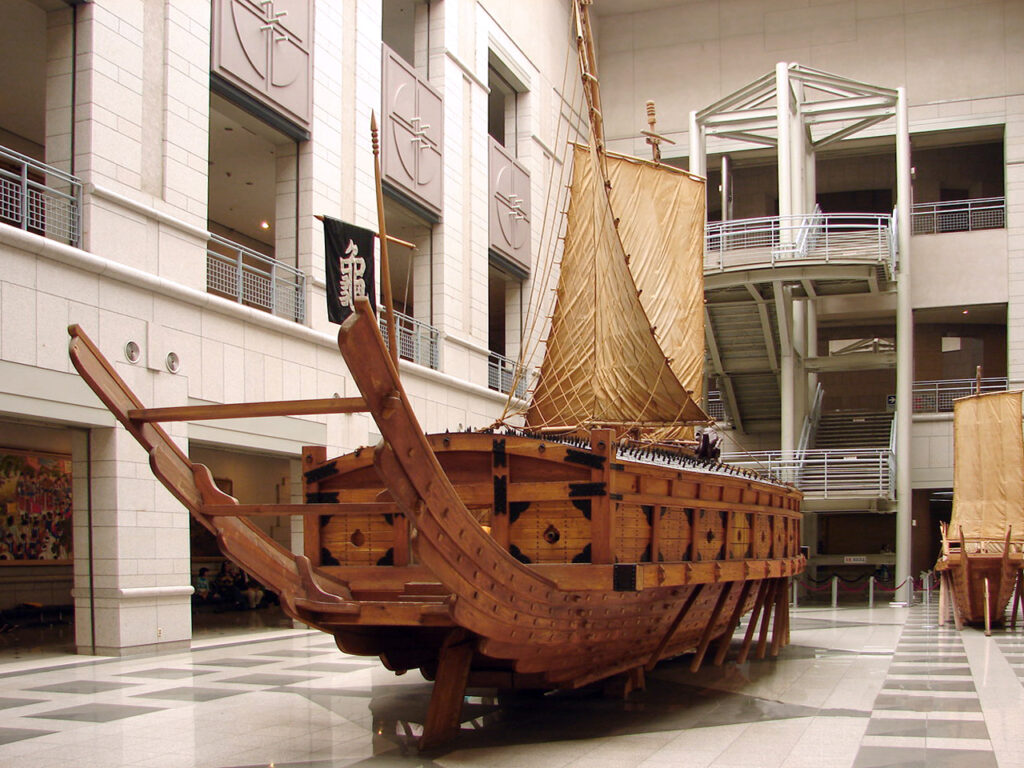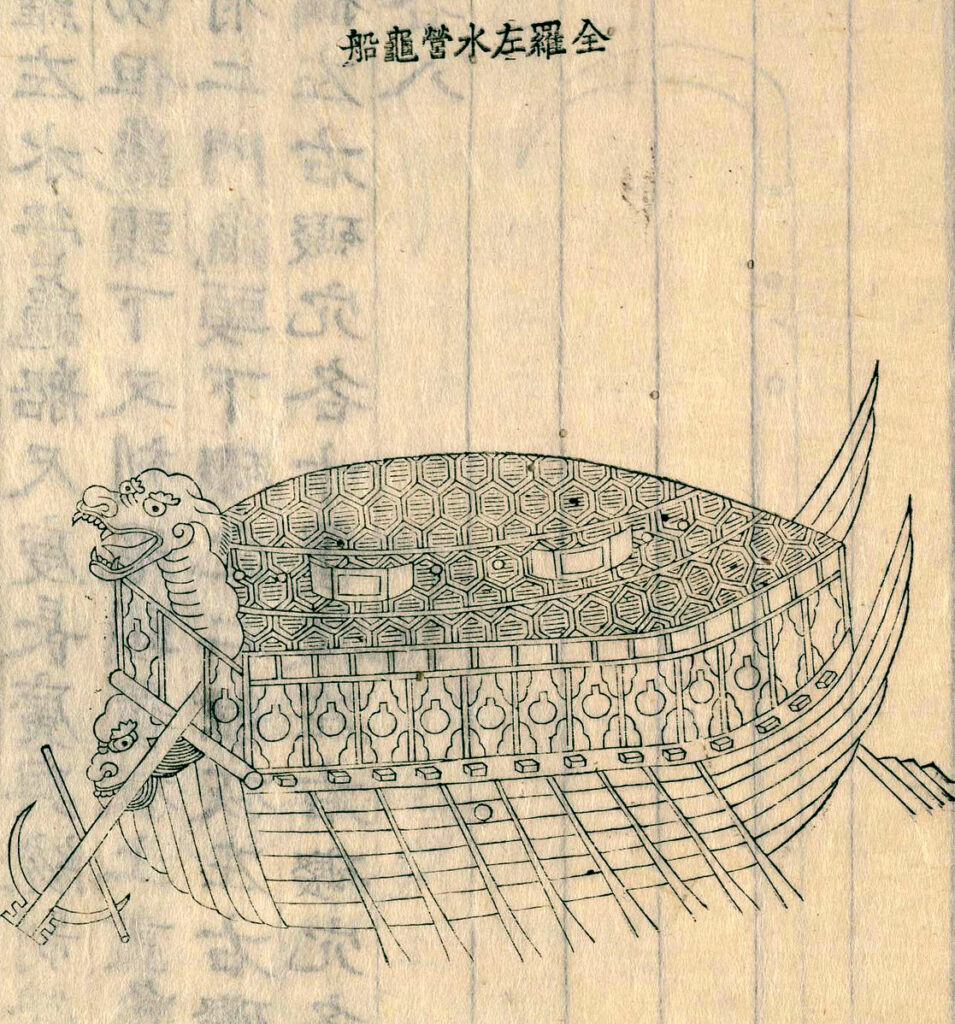The Korean turtle ship, or “geobukseon,” is sometimes considered the world’s first ironclad ship. It was a giant wooden ship with iron spikes covering the deck.
Now, to call it a true ironclad – that is, to suggest that it was covered in plates of metal – would be an exaggeration. But even so, the damage that these fearsome ships were able to inflict against Japan’s fleet in the late 16th century was enough to convert the turtle ship into a legend of naval combat history.
In this article, you’ll learn what a turtle ship is (and isn’t), the war that made it famous, and the man behind its destructive power.

What is a Turtle Ship?
The name “turtle ship” does little to convey the formidable-looking ship that this was.
Its first recorded use was during the Imjin Wars (also referred to as the Hideyoshi Invasions). During this, Japan tried unsuccessfully for seven years to conquer the Korean peninsula until a joint Chinese and Korean force defeated them in 1598.
The turtle ship that fought in this conflict was between 100 and 120 feet long and was equipped with two sails. It had a dragon’s head carved into its bow. But what made this ship distinct was the hard “shell” of iron that covered its exterior.
The ship was already sturdy to begin with, being built out of hardwoods like spruce and pine. But added to its strength and durability there may have been a thin layer of iron covering its top. What’s not clear from the historical record is if this layer of iron included an unbroken iron shell around the hull.
Some scholars claim that the turtle ship was an ironclad whose strength rested on its metal plating. But what is more likely is that its “shell” was a layer of wood into which soldiers could insert their spear tips from below.
These iron tips would have helped repel anyone trying to board. Moreover, the ship’s crew could place a heavy mat, soaked with water, over the metal points to give the ship a kind of shield against any fire attacks.
How Admiral Yi Sun-Shin Made the Turtle Ship Famous
If the Imjin Wars were the conflict in which the turtle ship emerged, Admiral Yi Sun-Shin was the man who is associated with its early use.
As an admiral serving the Joseon dynasty, Admiral Yi was in charge of a fleet of anywhere from five to eight turtle ships. He made effective use of these during the campaigns.
The invasion by Japan put Korea in a precarious position. As a vassal state of Mongol-ruled China, it was a key target in Japan’s attempt to conquer its larger neighbor. Bent on its total destruction, Japan, under Emperor Hideyoshi, sent a huge force that eventually numbered as many as 150,000 troops.
The vast Japanese army penetrated deep into the Korean peninsula. They burned Buddhist monasteries along the way and eventually reached the capital at Choson.
However, the Joseon dynasty had one advantage – Admiral Yi. Admiral Yi was considered a military genius, and in the Imjin Wars, he more than proved his worth as a leader.
For one thing, Admiral Yi had studied his enemy. He was well aware that the Japanese intended to fill their ships with archers who could release volleys of arrows against combatant ships, thus making it easier for the samurai to board.
Admiral Yi’s bold idea was to change the nature of naval warfare to give his fleet an advantage. Instead of trying to board the Japanese ships and confront their samurai head-on, he focused on long-range combat.
Each turtle ship was thus lined with dozens of 36-pound cannons, which fired through hatches. As he approached enemy forces, Admiral Yi would keep his ships in a single line so that cannon after cannon would have a clear shot at the enemy targets, thereby concentrating his firepower.

As a further impediment against enemy boarding parties, Admiral Yi supposedly invented a method of generating smoke by using sulfur and saltpeter, which would have provided a cover for his crew.
Last, he protected his crew using a thick wooden hull. Or, possibly a hull lined with a thin metal sheet, through which soldiers could poke their spears and impale any Japanese samurai who tried to board.
These tactics could be extremely deadly and helped turn the tide of the war. One of Admiral Yi’s favorite ploys was to feign retreat to bring the enemy out into open waters where he would proceed to unleash volley after volley of cannon fire and arrows.
He famously used this tactic at “The Great Victory of Hansando,” during which he destroyed 73 enemy ships.
The Korean Turtle Ship May Not Have Been So Decisive
The turtle ship’s exploits in battle were no doubt extraordinary. But what happened next demonstrates that it was not so much the ship itself that was special, rather it was Admiral Yi and his ability to outsmart the Japanese.
You see, Admiral Yi’s success came to be a curse in and of itself. After his success at Hansando, King Seonjo made him Supreme Naval Commander. But he had a jealous rival named Won Gyun who began plotting to discredit Admiral Yi and take his place.
To make a long story short, after Admiral Yi began questioning the king’s decision to negotiate with the Chinese, Won Gyun was able to construe his attitude as disloyalty to the King.
As a result, Admiral Yi was put in a cage and dragged throughout Korea as a form of punishment. He was then stripped of his command and made a regular soldier. At that point, Won Gyun took over command of Joseon’s naval forces. But he failed to live up to the skill of Admiral Yi.
When Japan launched a giant invasion force of 1,000 ships and 140,000 men in 1597, Won Gyun was easily defeated. The supposedly formidable turtle ships could do little against the Japanese. Won Gyun ended up trying to flee before being caught and beheaded.
Realizing the mistake that he had made in demoting Admiral Yi, King Seonjo once again made Admiral Yi Supreme Naval Commander. Just a year after Won Gyun’s humiliating defeat, Admiral Yi was able to crush a 500-ship Japanese navy, effectively ending the seven-year-long attempt to conquer the Korean peninsula.
The Imjin Wars mark a turning point in East Asian history. If the Japanese had been able to conquer Korea, they might have continued to take all of China, thereby altering the course of East Asian geopolitics.
Instead, Japan was dealt a devastating defeat from which it is said that Emperor Hideyoshi never recovered. At least a part of the credit for the way things unfolded can go to the turtle ship, an ingenious weapon of war that was made all the more formidable by one of history’s greatest admirals.

